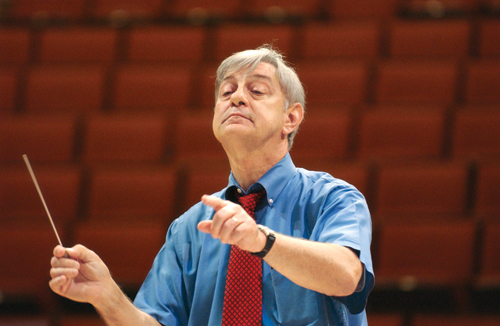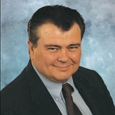.jpg)
Whether playing under the baton of Arthur Fielder or observing a local high school band in New Orleans, Herbert tries to incorporate the wisdom of others and pass it on to his music students. He has been a major figure in the development of the music program at Loyola University in New Orleans, and former students praise him as one of the most practical professors they have ever had. He admits that his teaching style has changed over the years in the never-ending quest to improve. Hebert earned degrees from Loyola University, Manhattan School of Music, and the University of Southern Mississippi. He is director of bands, coordinator of wind and percussion activities, and professor of music education at Loyola.
How has your conducting style evolved over the years?
During the first five or ten years I taught music I was focused too much on technique and tried to impress others with how fast we could play or how grand my technique was. I flew off the handle too often, but as I matured I learned not to say something sarcastic and then smile at the group to mitigate things. Gradually I became more patient and discarded sarcasm as a way to communicate. It is better to act professionally and avoid sarcasm. About 25 years ago I decided to change and found that I got a lot more done by sticking strictly to the business at hand.
I now talk less and stop less frequently than when I was a novice teacher. I also learned the benefits of having a complete rehearsal schedule on the board so everyone knows what we will rehearse. The percussion section doesn’t get out equipment that is not needed, and everyone has the music ready. On the podium I try to cover more than just the notes before us and give students a broader understanding of the musical process. I explain the terms and symbols in the music and identify other works this composer wrote.
I gradually learned that any section plays better when I focus closely on what they play. I also learned that scolding is less effective than explaining what is missing and how to improve it. The process of improving one section can be a benefit to everyone in a group.
What advice you do give students about rehearsal techniques?
I often rehearse from the back of a work to the front because many mistakes occur there. It is common to return to the beginning after correcting a mistake. The result is that by the time of a performance the beginning has been played many times while the ending of the piece may have been rehearsed just three times. I now often start with the last 15-20 measures and move forward in chunks of 25-30 bars and play through to the end each time. The result is that we have played the ending many times.
How would you describe an effective conducting style?
I try to conduct in a manner that reflects the style of the music. One way to test the effectiveness of this is to videotape a rehearsal and replay the tape without sound. If it is possible to sing the musical lines while watching the tape, a student or director has succeeded. Unfortunately, many conductors end up simply beating time and use the same gestures for fortissimo and pianissimo passages or on legato and staccato phrases. This is not good. Conductors who work this way will often stop to criticize students for playing too loudly or not staccato enough when in fact it is their conducting that is at fault. I suggest videotaping with the camera in the middle of the ensemble, not out where the audience would be. Only from this position is it possible to evaluate the conducting from the musicians’ viewpoint.
With an ensemble of any level I always point out whenever a student holds an instrument improperly. This is an essential element in playing well, and I want everyone to be aware of its importance.
What are other rehearsal techniques you pass along?
Bands do not include strings, but there are important lessons to learn from bowing techniques. For example, upbows usually do not get the same emphasis as downbows. When an eighth-note is followed by a quarter note after a bar line, many bands give the eighth note the emphasis when it should be on the quarter note. A string player knows that the eighth note will be an upbow and the quarter note a downbow, with the emphasis on the downbow.
What lessons did you pick up that improved your teaching?
Joe Novotny, once the principal tuba with the New York Philharmonic, taught me that each note should lead into the one that follows. Every phrase should be played with expression and clearly lead from one point to the next. For the tuba it is especially important to find good places to breathe. He explained that this often depends upon what else is going on in the orchestra. For example, in the second line of Tchaikovsky’s Romeo and Juliet, there is a B that goes on and on, too long to play with a single breath. He suggested breathing when another section enters because here the audience attention will be drawn to this new entrance.
What is some of the common wisdom you advise students to avoid?
I believe that most conducting books over-emphasize downward motions. I feel it is better to use broad, horizontal motions. I can understand when someone comes in a measure early or late, but it makes no sense for anyone to come in on the wrong beat if there is a clear, concise beat pattern. The clarity and direction of the stick should leave no doubt as to which beat it is.
The slow movement of Dvorak’s New World Symphony is best conducted in a subdivided four beat pattern. I have seen conductors use a vague Christmas tree pattern for this movement, following the downbeat with seven beats that alternate left and right, each a bit higher than the last. I chose to rehearse the movement in a subdivided four beat pattern so the ensemble could see where beats one, three, five, and seven were, making beats two, four, six, and eight smaller motions within the pattern.
How much sightreading do you advocate?
Some directors claim they don’t have time to sightread music with their ensemble, but some of them regularly come to me the week before a festival and ask to raid my library for music to sightread. No ensemble can learn to sightread in just the week before a festival or concert appearance. I believe that the better a group sightreads, the easier it is to prepare for a concert. One of the best ways to improve sightreading and ensemble playing is through forming trios, quintets, and small chamber groups. I believe students can rehearse and learn in a small ensemble on their own, without anyone coaching or waving a stick to lead them. Without a conductor they have to listen to each other in order to stay together.

How can a director improve the intonation?
Peter Domborium taught at a New Orleans high school, and I often pick his brain for ideas because he had taken the band to the Midwest Clinic and was then one of the few high school directors to belong to the American Bandmasters Association. When I asked how he got the band to play so well in tune, he replied that he never tuned instruments for students but required them to tune on their own. There are simply too many people in an ensemble for a director to tune. Domborium didn’t try.
I learned from him not to tell students if they are sharp or flat but to say that there is a problem and ask what they think it is. I will ask the whole band to identify who is flat or sharp. This forces students to listen and identify intonation problems. I have observed directors use an electronic tuner, moving from one student to another to identify who is sharp or flat. However, this approach gives students no reference tone to match. In rehearsals I use a sound generator to generate a pitch.
I strongly believe in the pyramid system advocated by Francis McBeth in his book (Effective Performance of Band Music, Southern Music). He uses the pyramid system to tune the ensemble but goes on to deal with balance. He envisions the ensemble as soprano, alto, tenor, and bass voices. To balance these voices he explains that the soprano should be softer than the alto, the alto less than the tenor. The loudest voice should be the bass to create a balanced sound.
What early teachers particularly influenced your conducting and teaching?
I learned a great deal about conducting phrases from Jonell Perlea, conductor of the Manhattan School orchestra in New York. Perlea was paralyzed on the right side. Coming to the United States from Germany, his English was minimal. He conducted the orchestra on a stool, using just his left arm. He started us off and that was it; there was no beat. He would bring you up and give a cue. Everything was done with a phrase, rather than a beat. His musicianship was incredible.
Ross Talbot, a student of Arnold Jacobs, was another strong influence. Talbot’s impeccable musical interpretation, comprehensive knowledge of the literature, and inspirational teaching encouraged me to pursue a master’s degree in performance at the Manhattan School in New York and explore musical performance as a career. Working with Talbot has influenced my teaching with undergraduate tuba students at Loyola. I use these same methods to instruct tuba students and methods class students on breathing, tone production, musical interpretation, and rehearsal techniques. My experiences in New York with the New York Philharmonic, American Symphony Orchestra, and various pickup orchestras such as the Boston Pops Orchestra, and with conductors Arthur Fiedler and Leopold Stokowski, serve as the foundation for my rehearsal, conducting, and teaching techniques. What has been particularly helpful is just watching and observing how these people work and talk with musicians.
What advice would you give novice directors?
My best advice is to watch other directors at work and determine which things they do that make sense to you. Don’t try to be that person, but adopt any ideas that seem useful, especially if this conductor has a fine ensemble. Go to every clinic you can and never hesitate to ask specific questions of anyone you admire. I have never had anyone respond that they are too busy or are unwilling to help. Openly admit to a veteran director that you have a problem and ask what they suggest. No matter how long you have been a director, there is always something more to learn. This is why even the veterans go to clinics. During one concert tour we were to play at a high school and arrived early. I found the rehearsal room and watched as the conductor stepped on the podium. Everyone became quiet and were silent whenever the director stopped during the rehearsal to give instructions. After the rehearsal was over, I mentioned to one of the students that it looked as though everyone was on their best behavior. He responded that it was simply understood that in the band room the seniors would make sure that the freshmen understood the tradition that everyone remains quiet whenever the director is on the podium.
Another tip I picked up by observing successful programs is that whenever students in these groups have a long rest, they often will conduct with their fingers along with the music. I have picked up and now ask students to do this. During a 20-measure rest they have a chance to develop as a future conductor. Very soon these motions become second nature for them.
Another tip I picked up by observing successful programs is that whenever students in these groups have a long rest, they often will conduct with their fingers along with the music. I have picked up and now ask students to do this. During a 20-measure rest they have a chance to develop as a future conductor. Very soon these motions become second nature for them.
I believe in hearing as many recordings as possible of works you will perform. Consider the differences between the interpretations. The notion that anyone will merely copy is silly and probably true for only a few directors. I encourage directors to play the finest recordings for students. If they hear the Marine Band play a work, it would be wonderful if they sounded exactly like this fine group. My view is that there is never only one way to play anything, even a Sousa march. Sousa himself would change things every time the band performed one of his marches. He altered things to fit the occasion for which it was performed.
I suggest to all of my college students that they play under many different conductors to pick up and copy those techniques that work. I have observed that many of my students and former students look exactly like their high school or college band director on the podium. I am aware that for some students I may become their pattern, but I encourage everyone to look at many others and decide which style they prefer on different aspects.
What advice would you give to veteran directors?
Continue playing your instrument and never stop. Attend as many concerts and clinics as possible as a way to learn what your colleagues are doing that you could adopt in your work. Shamelessly borrow any trick or technique that you like and skip the others. Keep thinking and learning as much as you can about music.






